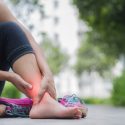
If you have been watching Ninja Warriors, I am sure you have been admiring the six-packs on display. Want to know how to achieve this? Firstly you need to understand what the core is!
What is the core?
The core includes the surface ‘beach’ muscles (rectus abdominis and the obliques), but also includes many other smaller, deeper muscles in the lower back, stomach and pelvis. These core muscles have a role in every movement that you do.
The deeper muscles work together with the surface muscles to provide effective ‘core stability’. Core stability means being able to maintain effective control of the spine and pelvis when you bend, twist and rotate, as well as when you maintain static positions (Kibler et al. 2006). By maintaining the stability of the spine and pelvis, the core muscles also provide a platform from which all other body parts can function with efficiency, control and safety.
Training for looks rather than function
The distinction between the abs that you can see and the core as a whole means that there are many people who may have a great looking six-pack, but are actually unable to hold their spine and pelvis steady during reaching, bending and loading tasks. The reason is that when most people train what they think is the core, they do it with the goal of improving the visual impact of the muscles. This is achieved (as with most body-building training) by performing exercises that isolate specific muscles to create definition in a desired area. This could include sit-ups, crunches, side bends and straight leg raises. While these exercises target muscles that are part of the core, they do so by activating single muscles at a time, and they never activate the core in a way that equates to activities outside the gym. In other words, there are very few movements in everyday life that resemble a sit up, so no matter how many sit-ups you do, they will never really prepare you for real-world loading. Additionally, some exercises that target the superficial muscles alone can actually increase the incidence of back pain and other injuries due to poor technique and muscle fatigue.
Training the core as a whole
Rather than training surface muscles in isolation, it is important to consider the role of the core muscles as a group. As the core’s role is to maintain spinal stability and provide a strong base for other movements, the focus of a core stability program is on effective stabilisation around the lower back and pelvic area. This should include activation training of the often neglected deeper core muscles such as transverse abdominis, the spinal extensor muscles and the pelvic floor (Ferreira et al, 2010). It can be quite difficult to learn how to activate these muscles if you have never trained them before. Physiotherapists are trained to assess and train these deep core muscles using advanced real-time ultrasound imaging. This can be extremely helpful in understanding how these muscles work and establishing an effective core training program. Once the focus is shifted from the surface muscles to the core as a whole, training is then progressed towards stabilising the spine during functional movements and real-world situations. This may be during 1:1 training sessions or in a physiotherapist-supervised Pilates class. Functional core stability training such as this can assist with injury prevention, pain reduction and improved tolerance of load (Hides et al, 2001).
Nic Toose is a Physiotherapist who has a special interest in core stability and Pilates. Nic works out of our Norwest rooms.
References
- Kibler, W.B., Press, J. & Sciascia, A. The role of Core Stability in Athletic Function. Sports Med (2006) 36: 189
- Hides JA, Jull GA, Richardson CA. Long-term effects of specific stabilizing exercises for first-episode low back pain. Spine. 2001;26(11):E243–E248
- Ferreira PH, Ferreira ML, Maher CG, Refshauge K, Herbert RD, Hodges PW. Changes in recruitment of transversus abdominis correlate with disability in people with chronic low back pain. British Journal of Sports Medicine. 2010 ;44(16):1166–1172








